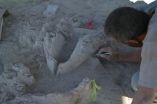(Press-News.org) An animal once believed to have disappeared from North America before humans ever arrived there might actually have roamed the continent longer than previously thought – and it was likely on the list of prey for some of continent's earliest humans, researchers from the University of Arizona and elsewhere have found.
Archaeologists have discovered artifacts of the prehistoric Clovis culture mingled with the bones of two gomphotheres – an ancient ancestor of the elephant – at an archaeological site in northwestern Mexico.
The discovery suggests that the Clovis – the earliest widespread group of hunter-gatherers to inhabit North America – likely hunted and ate gomphotheres. The members of the Clovis culture were already well-known as hunters of the gomphotheres' cousins, mammoths and mastodons.
Although humans were known to have hunted gomphotheres in Central America and South America, this is the first time a human-gomphothere connection has been made in North America, says archaeologist Vance Holliday, who co-authored a new paper on the findings, published this week in Proceedings of the National Academy of Sciences.
"This is the first archaeological gomphothere found in North America, and it's the only one known," said Holliday, a professor of anthropology and geology at the UA.
Holliday and colleagues from the U.S. and Mexico began excavating the skeletal remains of two juvenile gomphotheres in 2007 after ranchers alerted them that the bones had been found in northwestern Sonora, Mexico.
They didn't know at first what kind of animal they were dealing with.
"At first, just based on the size of the bone, we thought maybe it was a bison, because the extinct bison were a little bigger than our modern bison," Holliday said.
Then, in 2008, they discovered a jawbone with teeth, buried upside down in the dirt.
"We finally found the mandible, and that's what told the tale," Holliday said.
Gomphotheres were smaller than mammoths – about the same size as modern elephants. They once were widespread in North America, but until now they seemed to have disappeared from the continent's fossil record long before humans arrived in North America, which happened some 13,000 to 13,500 years ago, during the late Ice Age.
However, the bones that Holliday and his colleagues uncovered date back 13,400 years, making them the last known gomphotheres in North America.
The gomphothere remains weren't all Holliday and his colleagues unearthed at the site, which they dubbed El Fin del Mundo – Spanish for The End of the World – because of its remote location.
As their excavation of the bones progressed, they also uncovered numerous Clovis artifacts, including signature Clovis projectile points, or spear tips, as well as cutting tools and flint flakes from stone tool-making. The Clovis culture is so named for its distinctive stone tools, first discovered by archaeologists near Clovis, New Mexico, in the 1930s.
Radiocarbon dating, done at the UA, puts the El Fin del Mundo site at about 13,400 years old, making it one of the two oldest known Clovis sites in North America; the other is the Aubrey Clovis site in north Texas.
The position and proximity of Clovis weapon fragments relative to the gomphothere bones at the site suggest that humans did in fact kill the two animals there. Of the seven Clovis points found at the site, four were in place among the bones, including one with bone and teeth fragments above and below. The other three points had clearly eroded away from the bone bed and were found scattered nearby.
"This is the first Clovis gomphothere, it's the first archaeological gomphothere found in North America, it's the first evidence that people were hunting gomphotheres in North America, and it adds another item to the Clovis menu," Holliday said.
INFORMATION:
The dig at El Fin del Mundo, a joint effort between the U.S. and Mexico, was funded by the UA School of Anthropology's Argonaut Archaeological Research Fund, the National Geographic Society, the Instituto Nacional de Antropología e Historia and The Center for Desert Archaeology in Tucson.
In addition to Holliday, authors of the PNAS paper include: lead author Guadalupe Sanchez, who has a doctorate in anthropology from the UA; UA alumni Edmund P. Gaines and Susan M. Mentzer; UA doctoral candidates Natalia Martínez-Tagüeña and Andrew Kowler; UA master's student Ismael Sanchez-Morales; UA scientists Todd Lange and Gregory Hodgins; and Joaquin Arroyo-Cabrales at the Instituto Nacional de Antropología e Historia.
Meet the gomphothere: UA archaeologist involved in discovery of bones of elephant ancestor
2014-07-14
ELSE PRESS RELEASES FROM THIS DATE:
Acute glaucoma discovered to be an inflammatory disease
2014-07-14
Researchers at the University of California, San Diego School of Medicine and Sun Yat-sen University in China have shown that acute glaucoma in mice is largely an inflammatory disease and that high pressure in the eye causes vision loss by setting in motion an inflammatory response similar to that evoked by bacterial infections.
The study, published in this week's issue of the Proceedings of the National Academy of Sciences, has immediate clinical relevance in treating the tens of millions of people worldwide from what is known as acute closed-angle glaucoma.
"Our research ...
CRISPR system can promote antibiotic resistance
2014-07-14
CRISPR, a system of genes that bacteria use to fend off viruses, is involved in promoting antibiotic resistance in Francisella novicida, a close relative of the bacterium that causes tularemia. The finding contrasts with previous observations in other bacteria that the CRISPR system hinders the spread of antibiotic resistance genes.
The results are scheduled for publication in PNAS Early Edition.
The CRISPR system has attracted considerable attention for its potential uses in genetic engineering and biotechnology, but its roles in bacterial gene regulation are still ...
Older adults nearly twice as likely to have memories affected by distractions
2014-07-14
Older people are nearly twice as likely as their younger counterparts to have their memory and cognitive processes impaired by environmental distractions (such as irrelevant speech or written words presented along with target stimuli), according to a new study from psychologists at Rice University and Johns Hopkins University School of Medicine. Whereas other studies had found that older adults are distracted by memories of prior similar events, this was the first study to convincingly demonstrate across several tasks an impairment from environmental distractions.
"Cognitive ...
EARTH Magazine: Parasites spread across the Arctic under the 'new normal'
2014-07-14
Alexandria, Va. — The last several decades have seen Arctic sea-ice minimums drop by more than half in area and more than three-quarters in volume. With current models predicting further reductions, scientists are calling it the "new normal" and are trying to grasp its implications — one of which is the occurrence of pathogens never before seen in the Arctic.
Ice is a major eco-barrier for pathogens, but with Arctic ice diminishing rapidly amid the changing climate, pathogens have an opportunity to move into new areas and spread disease as mammals increase their ranges ...
Capturing cancer: A powerful new technique for early diagnosis
2014-07-14
Despite impressive medical strides, cancer remains a leading killer and overwhelming burden to healthcare systems, causing well over a half million fatalities per year with a projected cost of $174 billion by 2020, according to the National Cancer Institute. Reducing the human and economic toll will require diagnosis and intervention at early stages of illness, when the best prognosis for a cure exists.
In recent years, aggressive research and substantial financial investments have been directed at discovering pre-symptomatic indicators of cancer, known as biomarkers. ...
Labs characterize carbon for batteries
2014-07-14
Lithium-ion batteries could benefit from a theoretical model created at Rice University and Lawrence Livermore National Laboratory that predicts how carbon components will perform.
The model is based on intrinsic characteristics of materials used as battery electrodes. These include limitations on quantum capacitance (the ability of the material to absorb charge) and the material's absolute Fermi level, which determines how many lithium ions may bond to the electrodes.
Subtle changes in the structure, chemistry and shape of an electrode will alter how strongly lithium ...
Study: Young women with sexy social media photos seen as less competent
2014-07-14
BEND, Ore. – Girls and young women who post sexy or revealing photos on social media sites such as Facebook are viewed by their female peers as less physically and socially attractive and less competent to perform tasks, a new study from Oregon State University indicates.
"This is a clear indictment of sexy social media photos," said researcher Elizabeth Daniels, an assistant professor of psychology who studies the effect of media on girls' body image. Daniels' findings are based on an experiment she conducted using a fictitious Facebook profile.
"There is so much ...
Penn researchers successfully alleviate pulmonary inflammation with targeted drug delivery
2014-07-14
(PHILADELPHIA) – Pulmonary inflammation can cause shallow breathing and the lungs to become brittle in patients who experience multiple blood transfusions, sepsis, lung surgery and acute lung trauma. This complication can leave patients on ventilators, which can further traumatize the lungs, and often results in a mortality rate of 30 to 40 percent. To date, no medication has been successful at preventing or mitigating the damage caused by lung inflammation. Now, a multidisciplinary research team led by David Eckmann, MD, PhD, Horatio C. Wood Professor of Anesthesiology ...
Babies born in Canada to immigrant mothers have lower risk of cerebral palsy: Study
2014-07-14
TORONTO, July 14, 2014—Babies born to mothers who immigrated to Ontario from other countries have significantly lower rates of cerebral palsy than those of Canadian-born mothers, especially those from the Caribbean and East Asia, new research has found.
"Predicting who is at highest risk of having a child with CP remains an international priority," said lead author Dr. Joel Ray, who notes that CP rates have not declined much over the last decade.
CP is the most common motor disability in childhood and appears by the age of four. The underlying injury to the brain with ...
Avoiding abuse: Empathy, realistic expectations key to raising a child with disabilities
2014-07-14
ST. LOUIS – Children with developmental disabilities are at higher risk for abuse and neglect from parents than children developing at a typical rate. So far, there was little evidence of specific parental behaviors that were associated with the risk, but a SLU study finds inappropriate expectations and lack of empathy play a significant role in triggering the risk.
Debra Zand, Ph.D., associate professor of pediatrics at Saint Louis University and the principal investigator of the project, conducted the study in a small group of parents in St. Louis with 67 participants. ...






